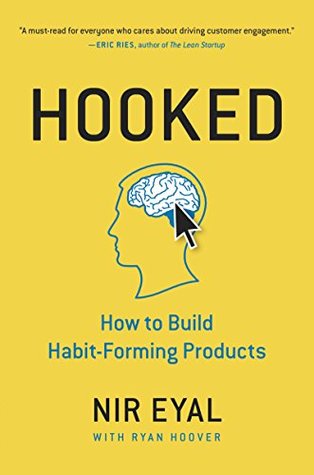More on this book
Community
Kindle Notes & Highlights
“automatic behaviors triggered by situational cues”:
Habit-forming products start by alerting users with external triggers like an e-mail, a Web site link, or the app icon on a phone.
This phase of the Hook, as described in chapter 3, draws upon the art and science of usability design to reveal how products drive specific user actions.
the ease of performing an action and the psychological motivation to do it.10 Once Barbra completes the simple action of clicking on the photo,
is dazzled by what she sees next.
craving.
Feedback loops are all around us, but predictable ones don’t create desire.
intrigue is created.
introducing variability does create a focused state, which suppresses the areas of the brain associated with judgment and reason while activating the parts associated with wanting and desire.
glittering
The exciting juxtaposition of relevant and irrelevant, tantalizing and plain, beautiful and common, sets her brain’s dopamine system aflutter with the promise of reward.
The investment phase increases the odds that the user will make another pass through the cycle in the future.
the investment implies an action that improves the service for the next go-around.
Inviting friends, stating preferences, building virtual assets, and learning to use new features are all investments users make to improve their experience.
she builds a desire to keep the things that
delight her. By collecting items, she gives the site data about her preferences. Soon she will follow, pin, repin, and make other investments, which serve to increase her ties to the site and prime her for future loops through Pinterest’s Hook.
trinity of access, data, and speed presents unprecedented opportunities to create positive habits.
Habits are defined as “behaviors done with little or no conscious thought.”
convergence of access, data, and speed
Hooked Model has four phases: trigger, action, variable reward, and investment.
Neuroscientists believe habits give us the ability to focus our attention on other things by storing automatic responses in the basal ganglia, an area of the brain associated with involuntary actions.2
Entrepreneurs should evaluate how user habits impact their particular business model and goals.
the amount of money made from a customer before that person switches to a competitor, stops using the product, or dies.
Hence, credit card companies are willing to spend a considerable amount of money acquiring new customers.
more likely to tell their friends about it.
Facebook’s success was, in part, a result of what I call the more is more principle—more frequent usage drives more viral growth.
Viral Cycle Time is the amount of time it takes a user to invite another user, and it can have a massive impact.
“But if you halved that cycle time to one day, you would have over 20 million users! It is logical that it would be better to have more cycles occur, but it is less obvious just how much better.”
As we will learn in chapter 5, users also increase their dependency on habit-forming products by storing value in them—further reducing the likelihood of switching to an alternative. For example, every e-mail sent and received using Google’s Gmail is stored indefinitely, providing users with a lasting repository of past conversations.
Altering behavior requires not only an understanding of how to persuade people to act—for example, the first time they land on a web page—but also necessitates getting them to repeat behaviors for long periods, ideally for the rest of their lives.
For one, new behaviors have a short half-life, as our minds tend to revert to our old ways of thinking and doing.
addressing shoppers’ price concerns, Amazon earns loyalty even if it doesn’t make the sale and comes across as trustworthy in the process.
Painkillers solve an obvious need, relieving a specific pain, and often have quantifiable markets.
Instead they appeal to users’ emotional rather than functional needs.
habit is when not doing an action causes a bit of discomfort.
My answer to the vitamin versus painkiller question: Habit-forming technologies are both.
Habits cannot form outside the Habit Zone, where the behavior occurs with enough frequency and perceived utility.
Habit-forming products often start as nice-to-haves (vitamins) but once the habit is formed, they become must-haves (painkillers).
But what causes the nacre to begin forming a pearl? The arrival of a tiny irritant, such as a piece of grit or an unwelcome parasite, triggers the oyster’s system to begin blanketing the invader with layers of shimmery coating.
Triggers provide the basis for sustained behavior change.
External triggers are embedded with information, which tells the user what to do next.
More choices require the user to evaluate multiple options.
Advertising, search engine marketing, and other paid channels are commonly used to get users’ attention and prompt them to act.
Favorable press mentions, hot viral videos, and featured app store placements are all effective ways to gain attention.
One person telling others about a product or service can be a highly effective external trigger for action.
Sometimes relationship triggers drive growth because people love to tell one another about a wonderful offer.
allure
While paid, earned, and relationship triggers drive new user acquisition, owned triggers prompt repeat engagement until a habit is formed.
Emotions, particularly negative ones, are powerful internal triggers and greatly influence our daily routines.
nagging issues. Positive emotions can also serve as internal triggers, and may even be triggered themselves by a need to satisfy something that is bothering us.


